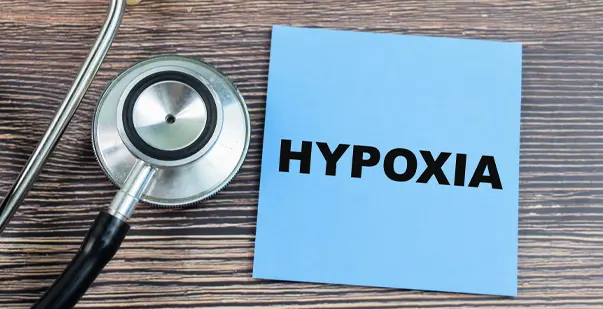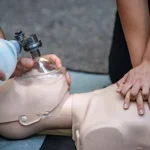Oxygen is essential for your cells to function, and when levels drop, serious health issues can arise. Hypoxia occurs when your body or a specific part of it doesn’t receive enough oxygen, leading to potential damage if not treated promptly.
Even a slight reduction in oxygen levels can cause confusion, shortness of breath, and dizziness. According to the National Institutes of Health (NIH), oxygen levels below 90% are considered dangerously low and can impair normal bodily functions.
This guide explains the symptoms, causes, and types of hypoxia. Let’s dive into the essential details that will keep you informed and better prepared to manage or prevent hypoxia.
What is Hypoxia?
Hypoxia occurs when your body is deprived of adequate oxygen. We all know that oxygen is important for every cell in our body. Without it, your organs can’t work properly. Thus, hypoxia can make a person feel sick and tired.
When you breathe, oxygen enters your lungs and moves into your bloodstream. Your blood then carries oxygen to every part of your body. If something interrupts this process, you might experience hypoxia.
You might wonder if hypoxia and hypoxemia are the same; they’re not. Hypoxemia means low oxygen in your blood, while hypoxia means low oxygen in your tissues. Hypoxia can happen even if your blood oxygen level is normal. It can affect your whole body or just a specific area. Almost one in four people who go to altitudes higher than 8,000 feet face hypoxia.
Hypoxia Symptoms
After learning what hypoxia is, you may wonder how to recognize it. Hypoxia can present itself in various ways, ranging from mild symptoms to more severe signs, depending on how low the oxygen levels drop and how quickly the condition develops. Here are the most common hypoxia symptoms:
- Restlessness: You might feel uneasy or jittery without any clear reason. This feeling of restlessness is your body’s way of signaling that it’s not getting enough oxygen. You may find it hard to sit still or relax, making it difficult to concentrate.
- Confusion: You might notice that you’re forgetting things or having trouble understanding simple instructions. This confusion happens because your brain isn’t receiving the oxygen it needs to function properly.
- Rapid Breathing: You may notice yourself breathing faster than usual. This rapid breathing, known as tachypnea, is your body’s attempt to take in more oxygen. However, even with faster breaths, you might still feel like you can’t catch your breath.
- Cyanosis (Bluish Skin): Your lips, fingers, or skin could turn bluish due to a lack of oxygen. This color change occurs because your blood isn’t carrying enough oxygen, causing areas with less blood flow to take on a bluish hue.
- Shortness of Breath: This is one of the most common symptoms of hypoxia, and it can happen even when you’re at rest. You may feel like you have to work harder to breathe or that your chest feels tight.
- Dizziness or Lightheadedness: Standing up or moving around might make you feel faint or unsteady. This dizziness occurs because your brain isn’t getting enough oxygen, which can affect your balance and make you feel like the room is spinning.
- Loss of Consciousness: If the oxygen level drops too low, you could pass out. This is a serious symptom that requires immediate medical attention, as it means your brain is severely deprived of oxygen.
- Seizures: In severe cases, your body might start shaking uncontrollably. Seizures are a sign that the brain is struggling to function without enough oxygen, and they can be life-threatening if not treated promptly.
- Coma: This is the most serious stage where you lose complete awareness of your surroundings. A coma indicates that the brain has been without oxygen for too long, and it may result in permanent damage if not addressed quickly.
Causes of Hypoxia
When oxygen is available in insufficient concentration for the body tissues to extract energy from food, normal bodily functions are severely affected. Several causes of hypoxia are behind such consequences, which are as follows:
- High Altitude: When you’re in high places like mountains, the air has less oxygen. This can make it hard for your body to get enough oxygen.
- Poorly Ventilated Spaces: If you’re in a place without good airflow, oxygen levels can drop. This might lead to hypoxia, especially if you stay there for a long time.
- Lung Diseases: Conditions like COPD, pneumonia, or asthma can stop your lungs from getting or using oxygen properly. This can lower the oxygen in your blood.
- Heart Conditions: Problems like heart failure, cardiac arrest, or congenital heart defects can affect how well your heart pumps oxygen-rich blood. If your blood isn’t circulating well, your body can’t get the oxygen it needs.
- Airway Obstruction: If something blocks your airway, like choking on food or an object, it stops oxygen from reaching your lungs. This can quickly lead to hypoxia.
- Chest or Lung Injury: Injuries from accidents, falls, or trauma can damage the lungs or chest. When this happens, the lungs might struggle to get oxygen into the blood.
- Anemia: When you have anemia, your blood doesn’t have enough hemoglobin. Hemoglobin is important because it carries oxygen. Without enough of it, your body might not get enough oxygen.
- Carbon Monoxide Poisoning: Breathing in carbon monoxide, often from car exhaust or faulty heaters, can stop your blood from carrying oxygen. Even small amounts can be dangerous.
Types of Hypoxia
Hypoxia is classified into different types based on the causes that decrease the available oxygen concentration in blood. Let’s take a look at these types of hypoxia so that appropriate measures can be taken on time to avoid the severe consequences:
- Hypoxic Hypoxia: Hypoxic hypoxia happens when there’s not enough oxygen in the air you breathe. This often occurs at high altitudes, where the air is thin. Your body struggles to get the oxygen it needs, leading to symptoms like shortness of breath and dizziness.
- Anemic Hypoxia: Anemic hypoxia occurs when your blood lacks enough hemoglobin to carry oxygen effectively. If you have severe anemia, your body can’t deliver enough oxygen to your tissues. As a result, you might feel tired and weak because your organs aren’t getting enough oxygen.
- Stagnant Hypoxia: Stagnant hypoxia occurs when blood flow is reduced or sluggish. This can occur in cases of shock or heart failure, where blood doesn’t circulate well. Because of this, oxygen doesn’t reach tissues properly, leading to cold extremities or fatigue.
- Histotoxic Hypoxia: Histotoxic hypoxia occurs when tissues can’t use oxygen properly, even if there’s plenty of it available. For example, cyanide poisoning can prevent cells from using oxygen. Despite normal oxygen levels in the blood, body cells can’t perform their functions, leading to serious symptoms.
Diagnosis of Hypoxia
Diagnosing hypoxia quickly is crucial for getting the right treatment. By using a few simple tests, you can find out if you have hypoxia and take action right away. Here are the key steps doctors use:
- Pulse Oximeter: This small device clips onto your finger and shows how much oxygen is in your blood. If the numbers are low, it might mean you have hypoxia.
- Arterial Blood Gas (ABG) Test: A small amount of blood is taken from your artery to measure oxygen, carbon dioxide, and pH levels. This test clearly shows how well your lungs are working.
- Imaging Tests: X-rays or CT scans help doctors see if there are problems in your lungs, like fluid or blockages, that could be causing hypoxia.
- Pulmonary Function Test: This test checks how well your lungs move air in and out. It can show if there’s a problem with how your lungs deliver oxygen to your blood.
Significance of CPR in Hypoxia
CPR (Cardiopulmonary Resuscitation) plays a crucial role in treating hypoxia, especially in emergencies where the brain and other vital organs are starved of oxygen. When someone experiences severe hypoxia, their breathing or heart may stop. In such cases, CPR can help maintain oxygen flow to the brain and body until professional medical help arrives. This immediate response can prevent permanent damage or even save a life.
Learning CPR is essential for everyone because you never know when you might need to use it. Being prepared can make all the difference in a critical moment.
Treatment Options for Hypoxia
Treating hypoxia requires quick action and a focus on getting more oxygen into your body. You can improve your symptoms by following the right steps and making some lifestyle changes. Here’s what you need to do:
- Oxygen Therapy: Breathe in pure oxygen through a mask or nasal tubes. This helps increase the oxygen in your blood quickly.
- Change Your Position: Sit or lie down with your head raised. This simple change can make it easier for you to breathe.
- Treat Underlying Conditions: If you have a lung or heart condition, follow your doctor’s treatment plan. Inhalers, medications, or other treatments can improve your oxygen levels.
- Quit Smoking: Smoking reduces the oxygen your body can use. Quitting smoking is one of the best ways to help your body breathe better.
- Adopt a Healthy Lifestyle: Eat well and stay active. A healthy diet and regular exercise help your body work better and use oxygen more efficiently.
Final Thoughts
The first key to maintaining good health is comprehending hypoxia. Knowing the hypoxia symptoms allows you to respond quickly if you or a loved one exhibits signs of low oxygen levels. Detecting Hypoxia early can prevent major issues from happening in advance.
Being aware of the reasons can help you avoid dangerous scenarios. Whether you’re avoiding high elevations or dealing with a medical issue, you have the power to manage your own health. Gaining knowledge about the various forms of hypoxia provides insight into potential occurrences within your body.
Always monitor your health and seek assistance if needed. With the appropriate knowledge and care, you can effectively handle hypoxia and lead a healthier lifestyle. Maintain a positive attitude and be in control of your health!
Read more:
CPR Compression Depth
Things To Learn In CPR & First Aid Training





